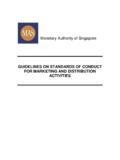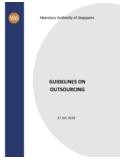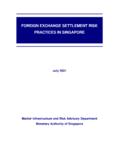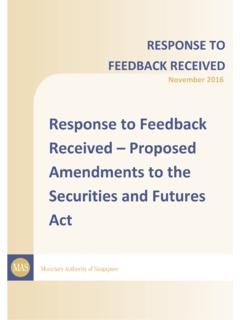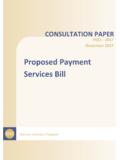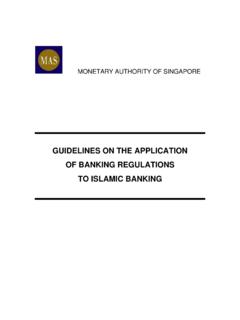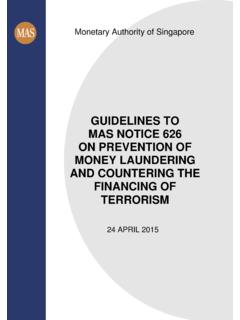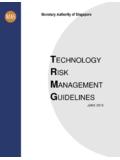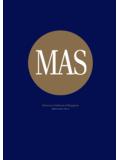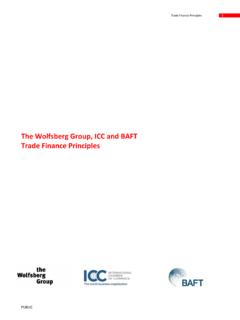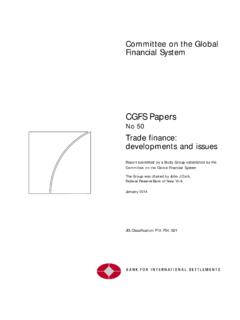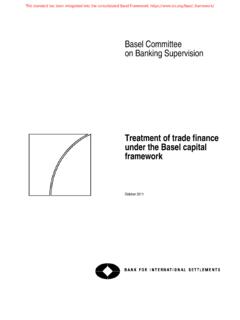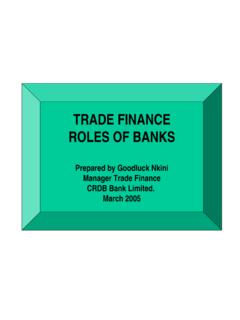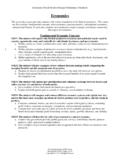Transcription of GUIDANCE ON ANTI-MONEY LAUNDERING AND …
1 Km Monetary Authority of Singapore GUIDANCE ON ANTI-MONEY . LAUNDERING AND. COUNTERING THE FINANCING. OF TERRORISM CONTROLS IN. trade finance AND. CORRESPONDENT BANKING. MAS Information Paper October 2015. AML/CFT CONTROLS IN trade finance AND CORRESPONDENT BANKING. Table of Contents 1 INTRODUCTION .. 3. 2 trade finance .. 4. Risk Assessment of trade finance Business .. 5. Due Diligence .. 5. Sanctions Controls .. 12. trade -Based money LAUNDERING Controls .. 14. Transaction Monitoring & Filing of Suspicious Transaction Reports .. 17. Policies and Procedures & Training .. 17. Potential Red Flags .. 19. 3 CORRESPONDENT BANKING .. 22. Due Diligence on Respondent Financial Institutions .. 22. Due Diligence on Group Relationships .. 26. Ongoing Monitoring of Respondent Financial Institutions .. 26. 4 CONCLUSION .. 29. MONETARY AUTHORITY OF SINGAPORE 2. AML/CFT CONTROLS IN trade finance AND CORRESPONDENT BANKING. 1 INTRODUCTION. In the National Risk Assessment report published in January 2014, MAS had identified the ANTI-MONEY LAUNDERING and countering the financing of terrorism ( AML/CFT ) controls for trade finance and correspondent banking as areas where there could be scope for improvement.
2 Robust controls in these areas enable banks1. to better prevent and detect the risks associated with trade -based money laundering2, proliferation financing and other sanctions compliance related issues. This paper aims to provide banks with GUIDANCE on the AML/CFT controls in trade finance and correspondent banking activities, assist them in their benchmarking against industry norms and in the implementation of sound risk management practices, and identification of control gaps. The observations were drawn from MAS'. on-site inspections and off-site reviews. The sharing of sound practices is intended to help banks further strengthen their controls and risk management. The examples in this document are not exhaustive. The GUIDANCE should be applied in a risk-based and proportionate manner, taking into account the risks posed by the customers, and the nature and complexity of the trade finance and correspondent banking activities of each bank. The contents of this GUIDANCE paper do not modify or supersede any applicable laws, regulations and requirements.
3 1. For the purpose of this paper, the term, banks , refers to banks, merchant banks and finance companies. 2. The term, trade -based money LAUNDERING , has been described by the Financial Action Task Force as the process of disguising the proceeds of crime and moving value through the use of trade transactions in an attempt to legitimise their illicit origins . MONETARY AUTHORITY OF SINGAPORE 3. AML/CFT CONTROLS IN trade finance AND CORRESPONDENT BANKING. 2 trade finance . As a trading and transportation hub, Singapore is vulnerable to money LAUNDERING ( ML ) risks posed by trade finance . Due to its significant volume and value, trade finance transactions are an attractive medium for money launderers to transfer large values across borders. trade finance can also be exploited for terrorism and proliferation financing ( TF/PF ). Significant concerns relating to these ML, TF or PF risks in trade finance (collectively known as financial crime risks in this paper) have been highlighted by other supervisory authorities and organisations such as the Financial Action Task Force ( FATF ) 3 , the Asia/Pacific Group on money LAUNDERING ( APG ) 4 and the Wolfsberg Group5.
4 From 2012 to September 2015, MAS conducted a series of inspections that covered banks' trade finance activities. This GUIDANCE paper provides details on pertinent observations arising from MAS' on-site inspections as well as GUIDANCE on identifying trade -based financial crime risks and implementing measures to mitigate such risks. Sound practices and areas where further attention is needed are also highlighted in this document. 3. The FATF is an inter-governmental body established in 1989. The objectives of the FATF are to set standards and promote effective implementation of legal, regulatory and operational measures for combating ML/TF and other related threats to the integrity of the international financial system. 4. The APG is an autonomous and collaborative international organisation founded in 1997 in Bangkok, Thailand consisting of 41 members including Singapore, and a number of international and regional observers. APG members and observers are committed to the effective implementation and enforcement of internationally accepted standards against money LAUNDERING and the financing of terrorism, in particular the Forty Recommendations.
5 5. The Wolfsberg Group is an association of thirteen banks that has developed a broad range of standards and a diverse program of activities which address ML risks and other financial crime risks, such as corruption, TF and sanctions. MONETARY AUTHORITY OF SINGAPORE 4. AML/CFT CONTROLS IN trade finance AND CORRESPONDENT BANKING. A Risk Assessment of trade finance Business Banks typically perform a risk assessment of their trade finance business as part of their overall risk management framework to better understand the financial crime risks they are exposed to as well as to assess whether control measures are in place to mitigate these risks. The trade finance -specific risk assessment could be part of the broader risk assessment performed by banks at the enterprise-wide level in Singapore. Such an assessment allows banks to identify the risk areas in their trade finance activities and determine whether the controls in place are robust. The enterprise-wide risk assessment is intended to enable the bank to better understand its vulnerability to ML/TF risks, including the financial crime risks presented by its trade finance business, and forms the basis for the bank's overall risk-based approach.
6 Attention Areas Banks should conduct a comprehensive risk assessment of their trade finance business, taking into account their customer base, geographical locations, products offered, and emerging risks if any, in determining the financial crime risks they are exposed to. Banks should also assess the adequacy of their risk management framework and internal controls to mitigate such risks. B Due Diligence The level of financial crime risks posed by customers and trade finance transactions differs based on their business, geographical locations, and risk profiles. Banks are expected to establish a sufficiently robust due diligence process to ensure that higher risk customers and transactions are subjected to more extensive due diligence measures and closer monitoring of transactions. A typical trade finance transaction involves a number of different parties. The parties range from buyer and seller, to their respective agents, bankers and intermediaries.
7 In general, banks should treat an instructing party in a trade finance transaction as their customer and conduct appropriate due diligence measures in accordance with a risk-based approach. The due diligence checks that should be conducted by banks depend on the role of the bank in the trade finance transaction. Given that the risk taken on by the bank at each stage of the transaction differs, there would also be a corresponding difference in the type and extent of due diligence measures required. The instructing MONETARY AUTHORITY OF SINGAPORE 5. AML/CFT CONTROLS IN trade finance AND CORRESPONDENT BANKING. party of a bank is determined by the bank's role in the transaction, for import documentary Letters of Credit ( L/Cs ), the instructing party for the L/C issuing bank is the L/C applicant; for export L/Cs, the instructing party for the L/C. advising/confirming bank is the L/C issuing bank or the first advising bank. Banks should establish guidelines to determine the instructing party, and the extent of due diligence measures to be conducted, in a trade finance transaction.
8 Additional Information to be obtained for trade finance Transactions In addition to the customer due diligence requirements set out in the MAS. Notices to Financial Institutions on Prevention of money LAUNDERING and Countering the Financing of Terrorism (thereafter referred to as the Notice ) 6 , banks are expected to obtain further information to assess the financial crime risks specific to a trade finance transaction. Banks should obtain additional information on other relevant parties (such as those set out in paragraph ) to a trade finance transaction, taking into account the bank's role in the transaction. Banks should develop clear procedures on the additional information required under various circumstances for all the relevant parties, including beneficiaries of L/Cs and documentary collections, agents and third parties identified. The type and timing of the additional information obtained depend on the bank's role in the transaction and should be in line with a risk-based approach.
9 This also applies to cases where a bank provides credit lines for, or facilitates open account trades ( invoice financing, pre-shipment financing, inventory financing) of its customers. Examples of such additional information are . (a) trading partners or counterparties of the customer (including buyers, sellers, shippers, consignees, notifying parties, shipping agents, etc.);. (b) nature of the goods traded;. (c) country or countries of origin of the goods (including whether the goods originate from any sanctioned country);. (d) trade cycle;. 6. The applicable MAS Notices include MAS Notice 626, MAS Notice 1014 and MAS Notice 824. MONETARY AUTHORITY OF SINGAPORE 6. AML/CFT CONTROLS IN trade finance AND CORRESPONDENT BANKING. (e) flag of vessel, flag history and name history (to check whether it is related to any country in the list of sanctioned countries);. (f) name and unique identification number ( International Maritime Organisation ( IMO ) number) of any vessel proposed to be used ( to better identify if it is ultimately owned by a sanctioned party).
10 (g) beneficial owner, commercial operator and registered owner of the vessel involved in the transaction to trace the history of former ship owners with focus on country of residence;. (h) port of loading, ports-of-call and port of discharge (including whether the goods originate from, or are sold to any sanctioned country) and the trade routes proposed to be used; and (i) market prices of goods such as commodities to assess if further information should be obtained where the contract price differs significantly from the market price to mitigate financial crime risk. Banks should verify information obtained on a trade finance transaction ( against commercial documents, transport documents, and on a risk-sensitive basis, from independent or public sources) to authenticate the details of the transaction. This should also apply to cases where banks provide credit lines for, or otherwise facilitate, open account trades ( invoice financing, pre-shipment financing, inventory financing) of their customers.
